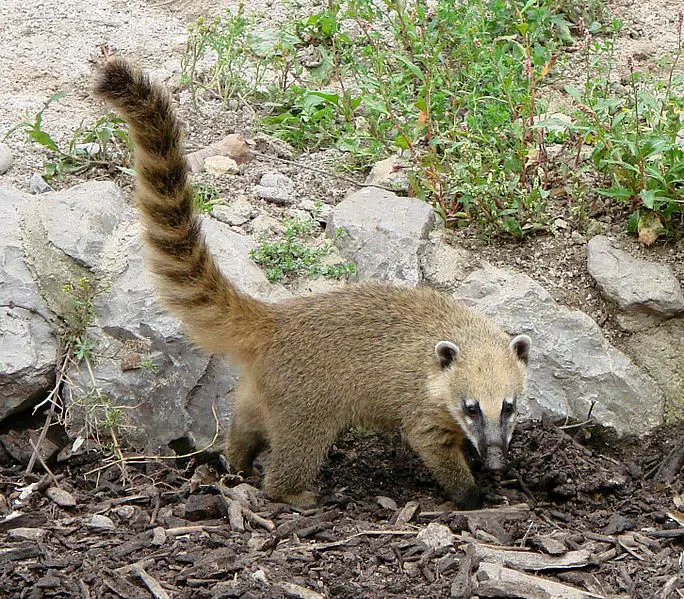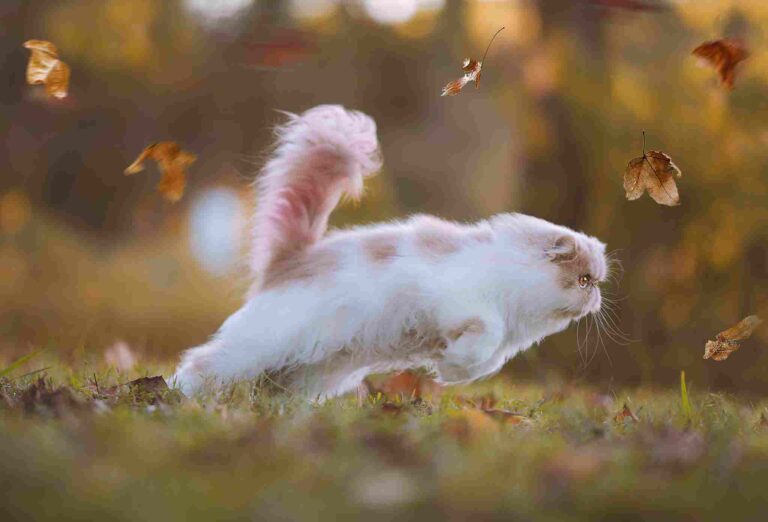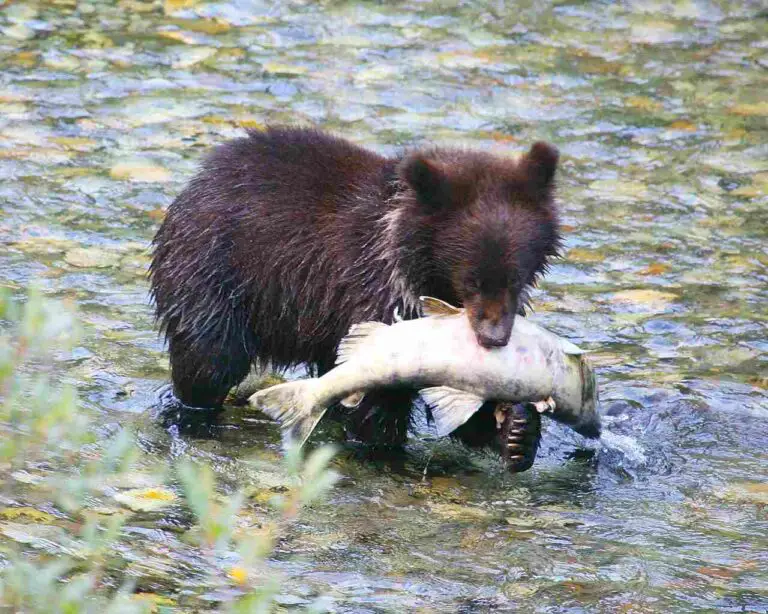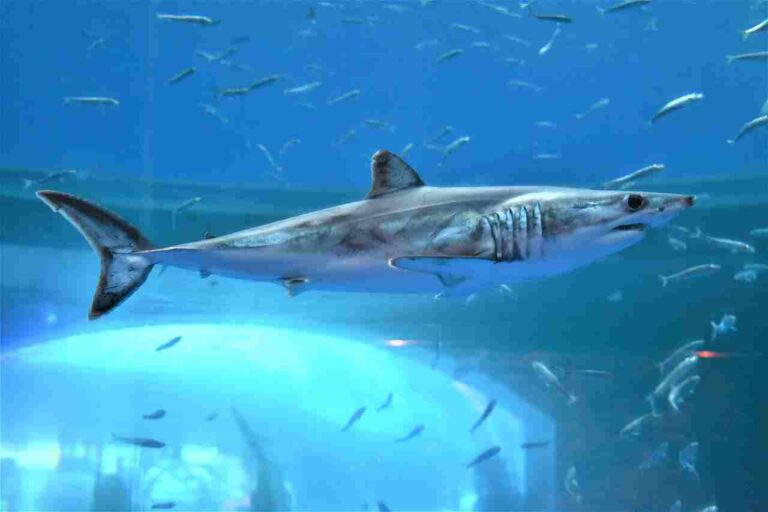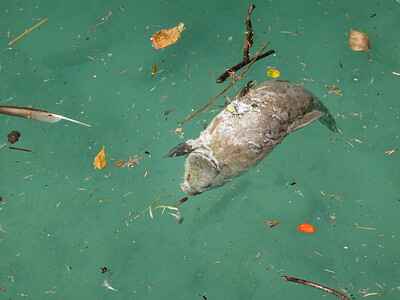Honey Badger Vs Mongoose Who Would Win, and Overall Comparison
Honey badgers and mongooses, both belonging to the Mustelidae family, exhibit distinctive characteristics that distinguish them within the animal kingdom. Honey badgers, known for their aggressive nature, and mongooses, recognized for their agility, present an intriguing scenario for a hypothetical confrontation. This analysis explores their taxonomy, appearance, size, weight, and aggressiveness while noting differences in fur color and morphological build to speculate on the potential outcome of a one-on-one clash between these two members of the Mustelidae family.
Honey Badger vs Mongoose: Evaluating the Likely Victor in a Confrontation
In a hypothetical one-on-one confrontation between a honey badger and a mongoose, the honey badger is likely to emerge victorious due to its heavier weight, larger size, superior strength, longer limbs, and heightened aggressiveness.
I). Weight and Size Advantage:
– Honey badgers, generally heavier and larger than mongooses, possess a significant advantage in terms of weight and size. This physical disparity gives the honey badger a potential upper hand in confrontations, where size and mass play crucial roles in determining dominance.
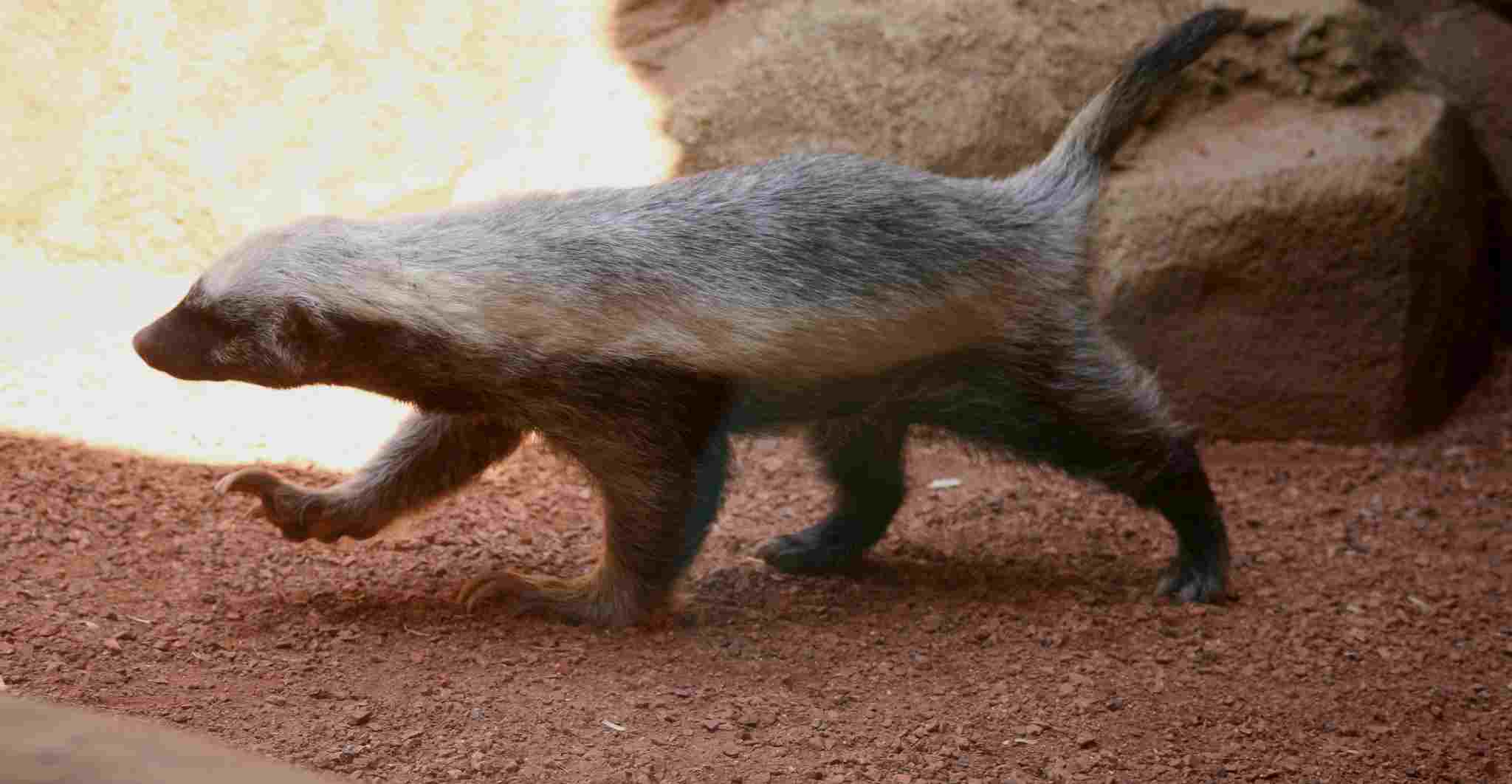
II). Strength Advantage:
– Honey badgers are known for their exceptional strength, which surpasses that of mongooses. This superior strength equips the honey badger with the power needed to control the dynamics of a confrontation, potentially overpowering the mongoose with ease.
III). Longer Limbs:
– Mongooses may exhibit agility, but honey badgers, with their longer limbs, have an extended reach that can be advantageous in a physical encounter. This morphological feature contributes to the honey badger’s ability to effectively engage with and dominate a mongoose.
IV). Aggressiveness:
– Honey badgers are renowned for their intense aggressiveness, often taking on animals much larger than themselves. In a confrontation with a mongoose, the honey badger’s heightened aggression could be a decisive factor, allowing it to take control of the encounter and subdue its opponent.
V). Overall Dominance:
– The combination of larger size, heavier weight, superior strength, longer limbs, and heightened aggressiveness positions the honey badger as the likely victor in a confrontation with a mongoose. While mongooses are agile, the overall traits of the honey badger give it a decisive advantage in determining the outcome of a physical clash.
*Details of Comparison
| Category | Honey Badger | Mongoose |
| Taxonomy | Kingdom: Animalia, Phylum: Chordata, Class: Mammalia, Order: Carnivora, Family: Mustelidae, Genus: Mellivora, Species: capensis |
Family: Herpestidae (Various genera and species)
|
| Appearance | Stocky, robust build; grey or black fur with white markings |
Sleek, elongated bodies; varied fur color and patterns
|
| Size | 55–77 cm (length), 12–30 cm (tail) |
Varies by species; ranges from 24 to 61 cm in length
|
| Weight | 9–16 kg |
Varies by species; generally 0.3 to 5 kg
|
| Bite Force | 50-60 kg/cm² |
Varies by species; generally not as powerful as honey badgers
|
| Physical Offensive Advantages | Powerful jaws, sharp claws; fearless disposition |
Sharp teeth, claws; agility and quick maneuvers
|
| Physical Defensive Advantages | Tough, loose skin; ability to escape into burrows |
Agility, speed; cooperative defense in social species
|
| Speed | Up to 30 km/h | Up to 40 km/h |
| Agility | Agile climbers, adept at digging; quick turns |
Highly agile, efficient in various terrains
|
| Overall Physical Capacity | Robust build, strength, agility; adaptable to different environments |
Varied physical capacities based on species
|
| Habitat Preference(s) | Wide range; grasslands to forests; arid and humid environments |
Diverse habitats; grasslands, forests, scrublands
|
| Tracks | Distinctive with visible claw marks |
Varies by species; generally smaller than honey badgers
|
| Lifespan | 7–10 years |
Varies by species; 6 to 13 years
|
| Mode of Feeding | Omnivorous; raids beehives for honey |
Varied diet; includes insects, mammals, eggs, fruits
|
| Social Behavior | Mostly solitary, occasional interactions; loose male associations |
Social; live in groups (troops); cooperative behaviors
|
| Mode of Reproduction | Solitary mating, minimal parental care |
Varied breeding; some monogamous, complex social structures
|
| Parental Behavior | Limited parental care; females raise offspring independently |
Varied parental behaviors; some exhibit cooperative care
|
| Proximity to Human Areas | Found in various habitats; may overlap with human settlements |
Adaptable to urban areas; may inhabit agricultural landscapes
|
| Behavior Toward Humans | Generally avoidant, aggressive if threatened |
Varies; some avoid humans, others may become accustomed
|
| Danger Posed to Humans | Considered dangerous; can inflict serious harm |
Generally not considered dangerous, may bite if threatened
|
| Associated Precautions | Caution advised; secure food sources to avoid attracting them |
Basic precautions often sufficient
|
| Conservation Status | Generally Least Concern; population trends vary |
Varies by species; some Least Concern, others Near Threatened or Endangered
|
| Conclusion – Similarities |
Adaptability; control insect populations
|
|
| Conclusion – Differences |
Social behaviors; conservation statuses
|
1. Taxonomy:
Honey Badger (Mellivora capensis)
Kingdom: Animalia
Phylum: Chordata
Class: Mammalia
Order: Carnivora
Family: Mustelidae
Genus: Mellivora
Species: capensis
Mongoose (Family: Herpestidae)
There are multiple species of mongoose within the Herpestidae family, with varied genera and species names. Examples include the Indian Gray Mongoose (Herpestes edwardsii) and the Banded Mongoose (Mungos mungo).
The taxonomy of the mongoose is broad due to the variety of species within the family.
2. Appearance:
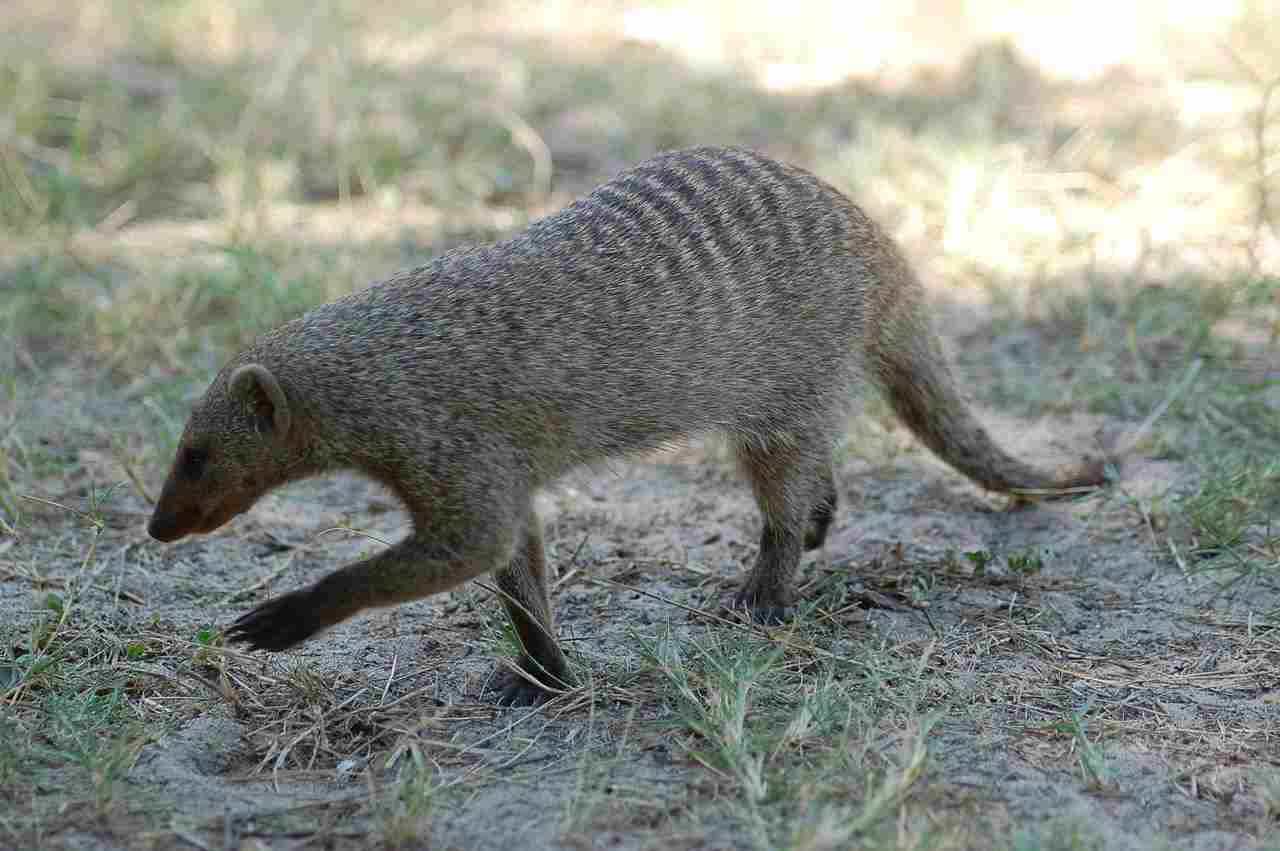
Honey Badger:
Stocky, robust build with loose, tough skin.
Thick fur, usually grey or black, often with a white stripe on the back.
Characteristic white facial markings.
Mongoose:
Varied appearances depending on the species.
Generally sleek, elongated bodies.
Fur color varies, including brown, grey, or striped patterns.
Comparison:
Honey badgers have a more compact build, while mongooses tend to be more streamlined.
Ecological Implications:
Honey badgers’ stocky build aids in digging, facilitating their ability to access prey hiding in burrows.
The mongoose’s sleek form is advantageous for swift movements, aiding in agility during hunting.
3. Size:
Honey Badger:
Length: 55–77 cm (22–30 in).
Tail: 12–30 cm (4.7–12 in).
Mongoose:
Sizes vary among species.
Ranges from 24 to 61 cm (9.4 to 24 in) in length.
Comparison:
Generally, honey badgers are larger than most mongoose species.
Ecological Implications:
The size of honey badgers contributes to their ability to take on larger prey.
4. Weight:
Honey Badger:
9–16 kg (20–35 lb).
Mongoose:
Weights vary significantly among species, ranging from 0.3 to 5 kg.
Comparison:
Honey badgers are substantially heavier than most mongooses.
Ecological Implications:
The honey badger’s weight aids in overcoming and dominating larger prey.
5. Bite Force:
Honey Badger:
Powerful jaws with a reported bite force of around 50-60 kg/cm².
Mongoose:
Bite force varies among species but is generally not as powerful as that of honey badgers.
Comparison:
Honey badgers possess a stronger bite force compared to most mongooses.
Ecological Implications:
The honey badger’s formidable bite is crucial for subduing and consuming a variety of prey.
6. Physical Offensive Advantages:
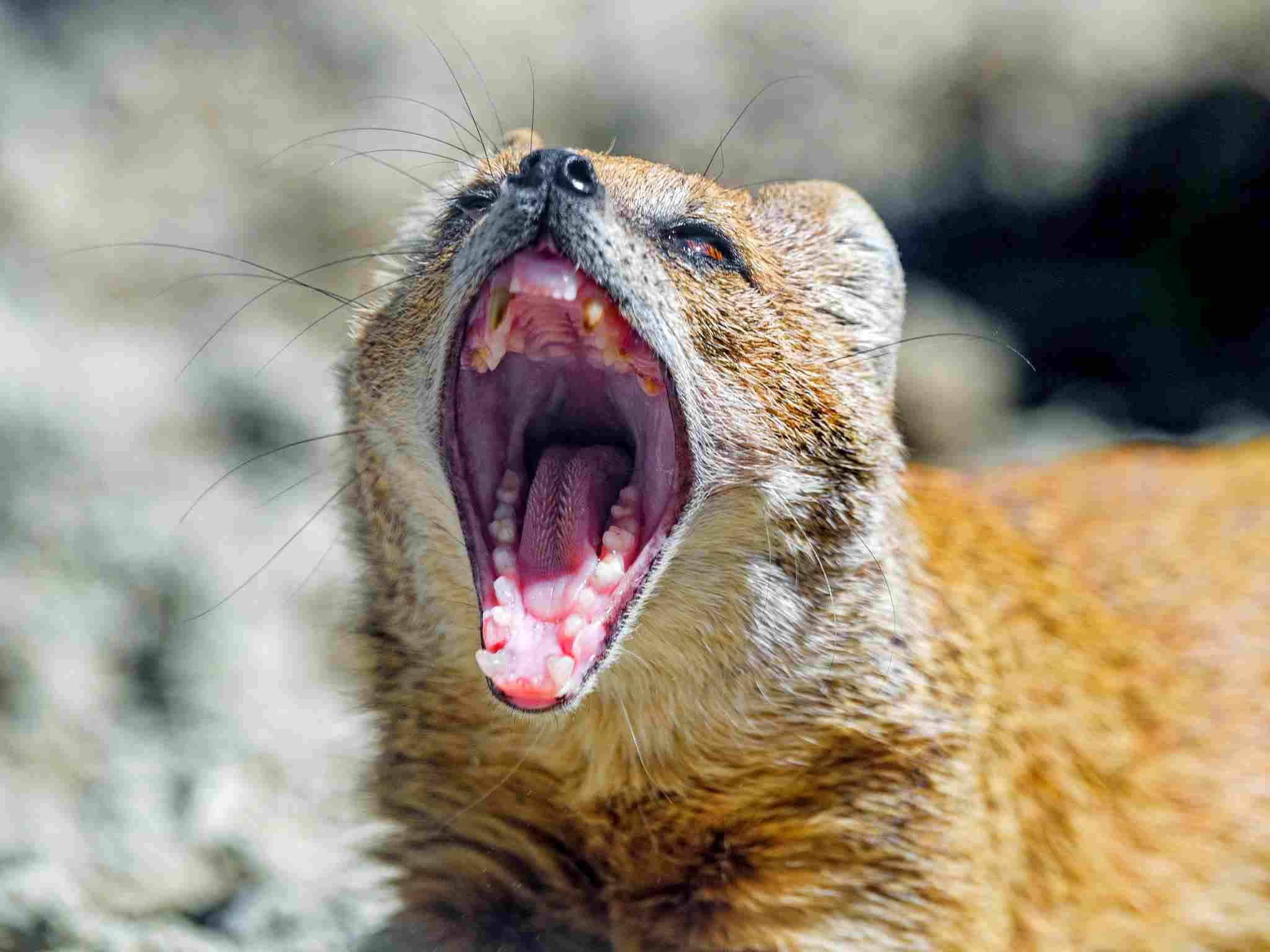
Honey Badger:
Powerful jaws and sharp claws.
Fearless disposition, known to confront and attack larger predators.
Mongoose:
Sharp teeth and claws.
Agile and capable of quick, evasive maneuvers.
Comparison:
Honey badgers are notably confrontational and have a reputation for taking on larger adversaries.
Ecological Implications:
The honey badger’s offensive capabilities contribute to its position as an apex predator in certain ecosystems.
7. Physical Defensive Advantages:
Honey Badger:
Tough, loose skin that can resist bites.
The ability to escape into burrows for protection.
Mongoose:
Agility and speed for evading predators.
Cooperative defense within social mongoose species.
Comparison:
Both honey badgers and mongooses rely on different defensive strategies.
Ecological Implications:
These defensive adaptations help them survive in diverse environments, balancing the risk of predation.
8. Speed:
Honey Badger:
Relatively fast runners with a top speed of around 30 km/h (18.6 mph).
Mongoose:
Agile and capable of reaching speeds up to 40 km/h (24.8 mph).
Comparison:
Mongooses generally exhibit higher running speeds compared to honey badgers.
Ecological Implications:
Speed is crucial for both species during pursuits of prey or while evading predators.
9. Agility:
Honey Badger:
Agile climbers and adept at digging.
Can twist and turn quickly, especially when engaged in combat.
Mongoose:
Highly agile, able to navigate through complex environments.
Agile when hunting and escaping predators.
Comparison:
Mongooses are often more agile and flexible in their movements.
Ecological Implications:
Agility enhances their hunting success and helps them navigate various terrains efficiently.
10. Overall Physical Capacity:
Honey Badger:
Robust physical build with a combination of strength and agility.
Well-adapted for both terrestrial and semi-aquatic environments.
Mongoose:
Varied physical capacities based on species.
Adaptability to different environments, often terrestrial.
Comparison:
Both honey badgers and mongooses display a balance of strength and agility, adapted to diverse habitats.
Ecological Implications:
Their versatile physical capabilities contribute to their ability to thrive in various ecological niches.
11. Habitat Preference(s):
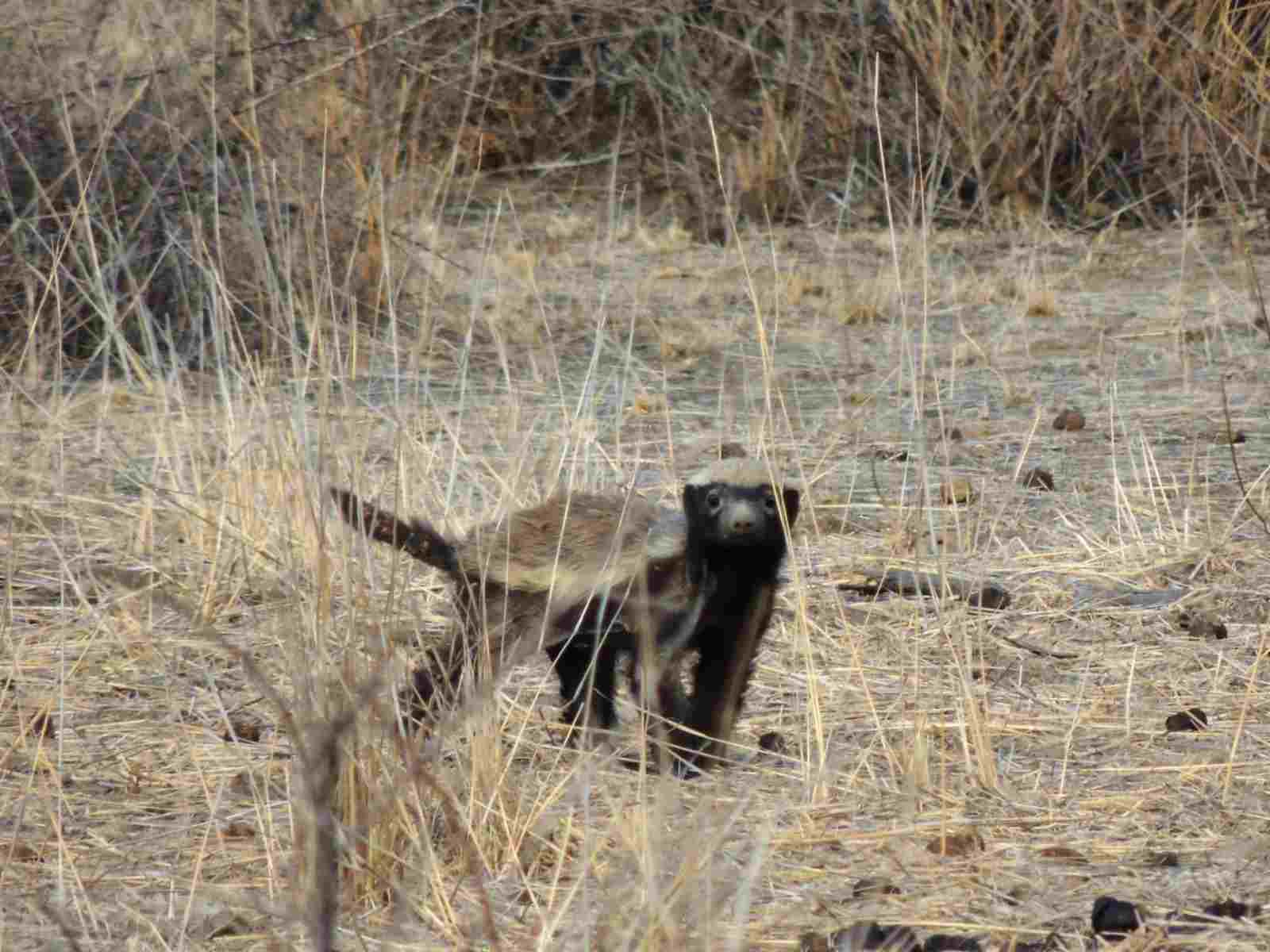
Honey Badger:
Wide range of habitats, from grasslands to forests.
Comfortable in both arid and more humid environments.
Mongoose:
Diverse habitats including grasslands, forests, and scrublands.
Some species also adapt to urban areas.
Comparison:
Both honey badgers and mongooses exhibit adaptability to a range of environments.
Ecological Implications:
Their ability to inhabit various ecosystems contributes to ecological balance in different regions.
12. Tracks:
Honey Badger:
Distinctive tracks with claw marks visible.
Mongoose:
Tracks vary among species, generally smaller than those of honey badgers.
Comparison:
Identification of tracks can help differentiate between the two species.
Ecological Implications:
Tracking can aid researchers in studying their distribution and behavior in the wild.
13. Lifespan:
Honey Badger:
Typically 7 to 10 years in the wild.
Mongoose:
Lifespan varies by species, ranging from 6 to 13 years.
Comparison:
Honey badgers and mongooses share relatively similar lifespans.
Ecological Implications:
Lifespan influences population dynamics and ecological roles within their respective ecosystems.
14. Mode of Feeding:
Honey Badger:
Omnivorous diet, includes small mammals, birds, reptiles, insects, and fruits.
Known for raiding beehives to feed on honey.
Mongoose:
Varied diet, includes insects, small mammals, birds, eggs, and fruits.
Some species have adapted to eat venomous snakes.
Comparison:
Both species are opportunistic feeders with varied diets.
Ecological Implications:
Their feeding habits contribute to controlling insect populations and maintaining ecosystem balance.
15. Social Behavior:
Honey Badger:
Mostly solitary, with occasional social interactions.
Male honey badgers may form loose associations during mating season.
Mongoose:
Social animals, often living in groups called troops.
Cooperative behaviors, such as group defense against predators.
Comparison:
Mongooses are generally more social than honey badgers.
Ecological Implications:
Social behaviors impact group dynamics, influencing hunting strategies and protection against predators.
16. Mode of Reproduction:
Honey Badger:
Generally solitary in mating, with minimal parental care.
Mongoose:
Breeding varies among species, but many are monogamous or have complex social structures.
In some species, the dominant female is the primary breeder.
Comparison:
Honey badgers typically exhibit more solitary breeding behaviors compared to some mongoose species.
Ecological Implications:
Different reproductive strategies contribute to population dynamics within their respective ecosystems.
17. Parental Behavior:
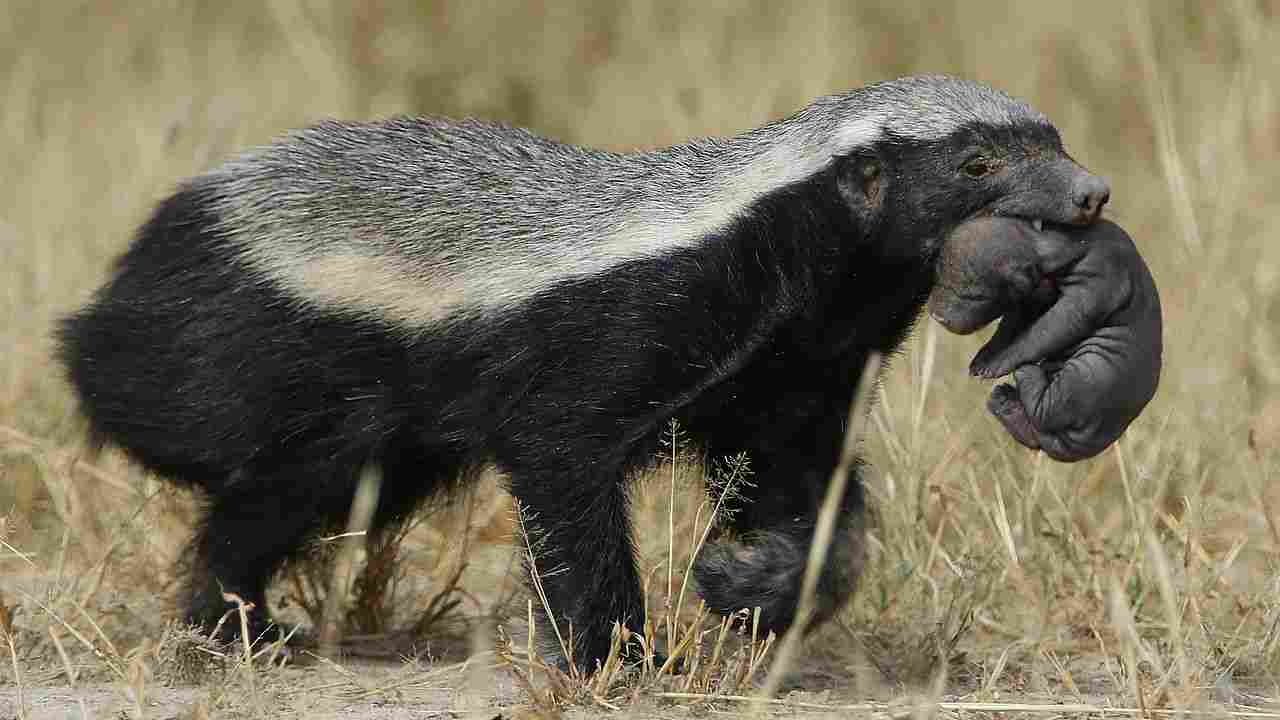
Honey Badger:
Limited parental care, with females raising offspring independently.
Mongoose:
Varied parental behaviors, with some species exhibiting cooperative care within the group.
Comparison:
Mongooses often show more cooperative parental care compared to honey badgers.
Ecological Implications:
Parental behaviors influence the survival rates of offspring, impacting population dynamics in their habitats.
18. Proximity to Human-Inhabited Areas:
Honey Badger:
Can be found in various habitats, including savannas and deserts, often overlapping with human settlements.
May raid poultry farms or garbage bins.
Mongoose:
Some mongoose species adapt to urban areas, living close to human populations.
Known to inhabit agricultural landscapes.
Comparison:
Mongooses, due to their adaptability, may be more commonly found in proximity to human settlements.
Ecological Implications:
Human-mongoose interactions may impact both species and require management strategies to minimize conflicts.
19. Behavior Toward Humans:
Honey Badger:
Generally avoidant of humans but can be aggressive when cornered or threatened.
Mongoose:
Behavior varies; some may avoid humans, while others in urban areas may become accustomed to human presence.
Comparison:
Both species may exhibit defensive behaviors if they feel threatened by humans.
Ecological Implications:
Understanding their behavior toward humans is crucial for conservation efforts and mitigating potential conflicts.
20. Danger Posed to Humans:
Honey Badger:
Considered dangerous due to their tenacious nature; can inflict serious harm if provoked.
Mongoose:
Generally not considered dangerous to humans, but may bite if cornered or feels threatened.
Comparison:
Honey badgers are perceived as more dangerous to humans compared to mongooses.
Ecological Implications:
Perception of danger can influence human-wildlife interactions and conservation efforts.
21. Associated Precautions:
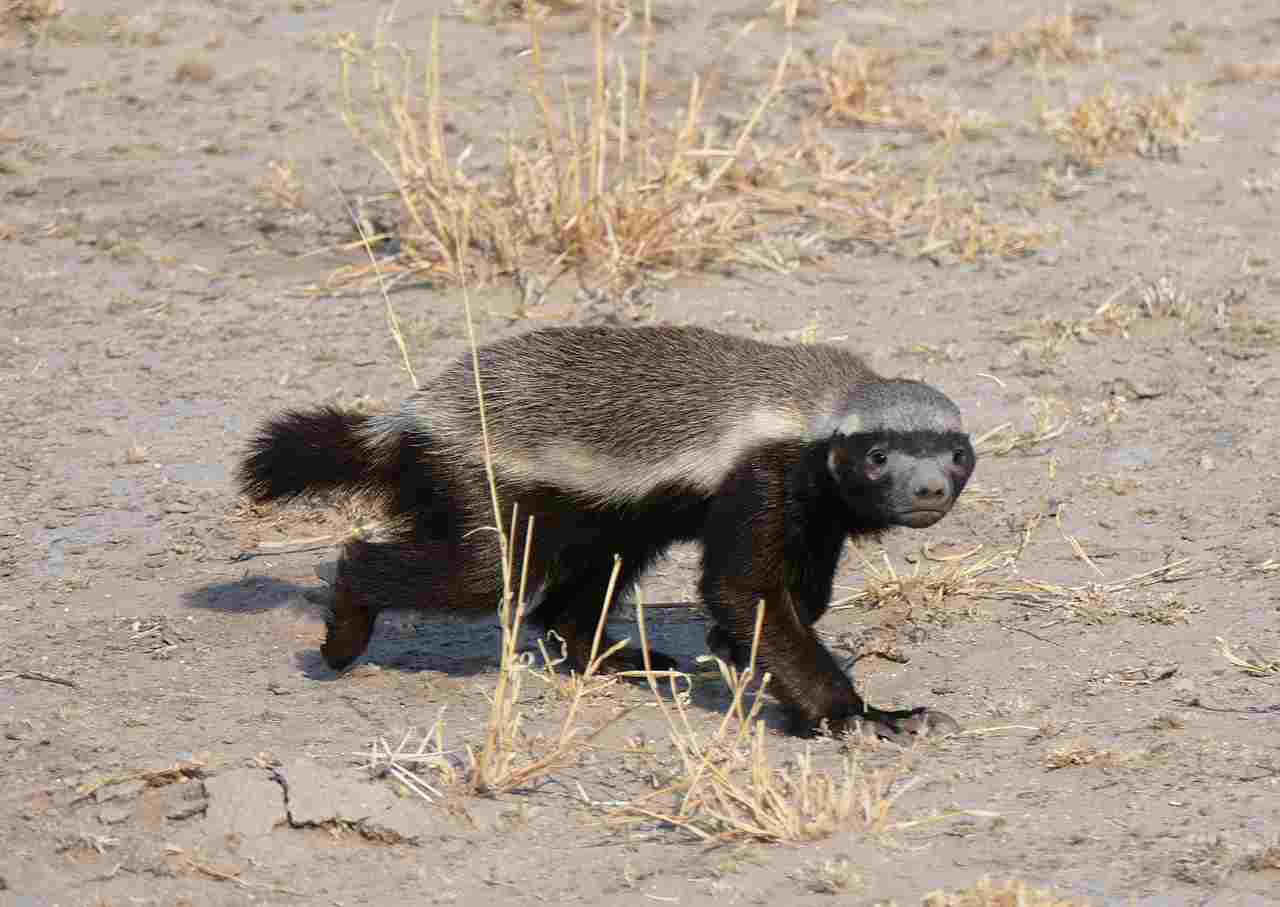
Honey Badger:
Caution advised, especially in areas where honey badgers are known to be present.
Secure food sources to avoid attracting them.
Mongoose:
Generally, basic precautions such as avoiding direct confrontation are sufficient.
Comparison:
Precautions may need to be more stringent in areas with honey badger populations.
Ecological Implications:
Implementing precautions helps in promoting coexistence and minimizing conflicts between humans and wildlife.
22. Conservation Status:
Honey Badger:
Generally considered a species of Least Concern.
Population trends can vary regionally.
Mongoose:
Conservation status varies by species; some are of Least Concern, while others may be Near Threatened or Endangered.
Comparison:
Conservation status is species-specific, with some mongoose species facing greater threats.
Ecological Implications:
Conservation efforts may need to focus on specific mongoose species to ensure their survival in certain regions.
Summary of the Comparison
Taxonomy:
Honey Badger: Mustelidae family, genus Mellivora, species capensis.
Mongoose: Herpestidae family, various genera and species.
Appearance:
Honey Badger: Stocky, robust, grey or black fur with white markings.
Mongoose: Sleek, elongated bodies, varied fur color, and patterns.
Size:
Honey Badger: 55–77 cm in length, 12–30 cm tail.
Mongoose: Varies by species, generally 24 to 61 cm in length.
Weight:
Honey Badger: 9–16 kg.
Mongoose: Varies by species, generally 0.3 to 5 kg.
Bite Force:
Honey Badger: 50-60 kg/cm².
Mongoose: Varies by species, generally not as powerful as honey badgers.
Physical Offensive Advantages:
Honey Badger: Powerful jaws, sharp claws, fearless disposition.
Mongoose: Sharp teeth, claws, agility, and quick maneuvers.
Physical Defensive Advantages:
Honey Badger: Tough, loose skin, ability to escape into burrows.
Mongoose: Agility, speed, cooperative defense in social species.
Speed:
Honey Badger: Up to 30 km/h.
Mongoose: Up to 40 km/h.
Agility:
Honey Badger: Agile climbers, adept at digging, quick turns.
Mongoose: Highly agile, efficient in various terrains.
Overall Physical Capacity:
Both exhibit versatility in physical capabilities, balancing strength and agility.
Habitat Preference(s):
Both adapt to a variety of environments, including grasslands, forests, and urban areas.
Tracks:
Distinctive tracks with claw marks for honey badgers; smaller tracks for mongooses.
Lifespan:
Honey Badger: 7–10 years.
Mongoose: Varies by species, generally 6 to 13 years.
Mode of Feeding:
Both are opportunistic omnivores with varied diets.
Social Behavior:
Honey Badger: Mostly solitary; occasional social interactions.
Mongoose: Social, living in groups (troops), cooperative behaviors.
Mode of Reproduction:
Both exhibit different breeding strategies, with honey badgers being more solitary.
Parental Behavior:
Limited parental care for honey badgers; varied parental behaviors for mongooses.
Proximity to Human-Inhabited Areas:
Both may inhabit areas close to human settlements; mongooses may be more adaptable to urban areas.
Behavior Toward Humans:
Generally avoidant but can be aggressive when threatened.
Danger Posed to Humans:
Considered dangerous for honey badgers; mongooses generally not considered dangerous.
Associated Precautions:
Caution advised for honey badgers; basic precautions often sufficient for mongooses.
Conservation Status:
Generally Least Concern for honey badgers; varies by species for mongooses, with some facing higher threats.
Conclusion – Similarities:
Adaptability to various environments.
Contribution to controlling insect populations.
Conclusion – Differences:
Social behaviors.
Conservation statuses.
Conclusion:
I). Similarities:
Both honey badgers and mongooses exhibit adaptability to various environments.
Both play roles in controlling insect populations, contributing to ecosystem balance.
II). Differences:
Social behaviors differ, with mongooses being more social than honey badgers.
Conservation statuses vary, with some mongoose species facing higher threats than honey badgers.
